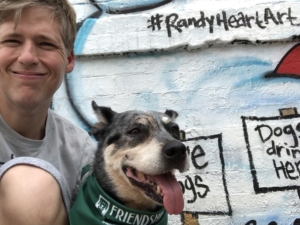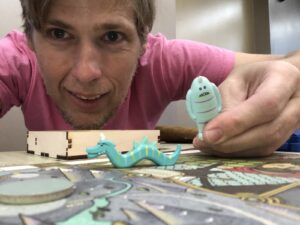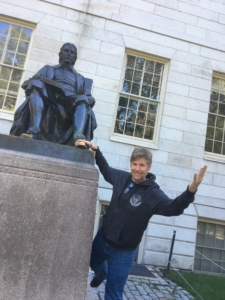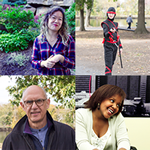Faces Behind the Screen: Michael
Quick Links

“I grew up without having identified as a capital “D” – Deaf. I emphasize the capital D to show the value of Deaf identity. I wasn’t sure if I was hard of hearing or not. I had a lot of friends who signed, but all of them signed English, called S-E-E, SEE. I felt trapped. I didn’t meet a lot of deaf people out in the community.
After graduating high school, I started to meet different people in college. That’s when my bubble burst. Oh, man, did I really get engrossed in everything! I still struggled with my identity during that time I went to Gallaudet. I also had my own geek culture from growing up. At this point, I had to assess myself.
With determination, I recognize myself as a Deaf person. I kept myself motivated to accommodate life with the usage of ASL. That’s when I became and started to identify with the capital “D” in Deaf.
In the 80s, my parents had this baby that was born deaf. And they didn’t know exactly what to do. Based on the doctor’s recommendation, they gave me the hearing aids. The doctor said, “Michael will need learn English.” During the 80s, ASL was not recognized as a formal language. My mother decided to follow the doctor’s recommendation. Other options were not offered at that time. There was not enough exposure of Deaf Culture or Deaf community. People viewed the deafness and see it as a disability.
There was a reason that my mother wanted to ensure that I learned English so I could be able to speak. She wanted to make me as normal as possible, so I could fit into the world. She wanted me to have better opportunities of life based from the doctor’s perspective.
At that time, people did not believe children were able to study two different languages. It was a crazy concept. They didn’t think it was possible. My parents decided to keep me focused on English and Signed Exactly English throughout the school year. My parents thought it was a benefit to me, for a long while, I disagreed with them. Today, I realized it doesn’t matter because they were there for me all my life. I still love my parents.”
When I was a kid I loved picture books – any kind of picture books. I’m a visual person, not a linguistics person.
I had to grow up with SEE. I’m pretty good with English. But still, I still struggle with expressing English. ASL is a visual-dependence language– I get engrossed in it. When you asked me for an interview, the method was either using a videophone or email. I chose the videophone. If I chose using the email to respond, then I’d have a harder time answering your questions. ASL gave me that confidence to express myself. That’s the best thing about being Deaf.
A few years ago, I started a new hobby of board games. Over the years, I noticed socializing/playing with hearing people using a board game made communication easier. Since we all know the rules to play the games, we didn’t have to face the language barrier. All board games have set rules that we followed. It was easy to teach them the sign language through the board game rulebook. This is a great way to share and expose ASL to anyone who wants to learn/play.
Combining ASL and the board games, the communication went smoothly because of how we use visual cues. I embolden hearing people to develop connections with the deaf people and vice versa. Any kind of socializing through a game– I highly encourage that. I apply this method of gaming and signing a lot in my classroom now. It benefits the students while making it fun.
ASL is what I truly identify with my culture. This language is beautiful and robust. I feel capable and committed to ASL.

In the Deaf world and the hearing world– you have these two separate things– technology helps living in the hearing world a ton. My phone, for example, has dictation that I can click on. You could speak, and it pops up with bold sentences. I can put it in use for communicating with hearing people. If I take my dog to the vet, I have my phone dictate what the doctor is saying. The dictation of the doctor’s instruction can be saved in the data. That alone has helped me have access into the hearing world.
In the Deaf world, technology has also made an impact. I’ve noticed that socializing, like human contact, has kind of been removed by technology. In the past, especially at Gallaudet and any Deaf clubhouse, the Deaf would come together and hang out. There wouldn’t be texting going on or anything like that. Every week, or every month, there were different events. But then since technology has increased, people just communicate more through text messaging. There’s still positives and negatives to technology. But the biggest positive is that look, I can communicate with you through the VRS services, for this interview.
As for captions, I try to avoid watching movies that do not include captions. Actually, I refuse to watch a movie without captions. I refuse to do it at all. It’s cringing frustrating when you go to the movie theater to watch a movie, and you have to deal with the glasses or the one where you had to adjust into your cupholder, hoping no one bumps into it. There are a number of different kinds of devices in theaters. The worst one is the rear window captioning. It’s a reflective glass where you read the caption. The captions come from an LED display monitor in the back of the theater. Even with the modern glass I struggled with how I line up the captions through the glasses on the screen. I get really disappointed whenever the glass skips a line or you miss a joke. (I can see the audience laughing.)
You miss out on a lot of the information. It’s agonizing for our movie experiences as Deaf people. When I come to a theater expecting captioning and there are no captions al all, then I get nauseated. It ruins the movie-going experience too, especially when there’s a glitch in the captioning device. It’s awful when the captions are delayed – I get behind with the story. Live captioning shares a similar problem, especially when watching the news. Those issues are challenging us to fix it.
Faces Behind the Screen is a storytelling project focusing on communities that benefit from a more accessible web.




